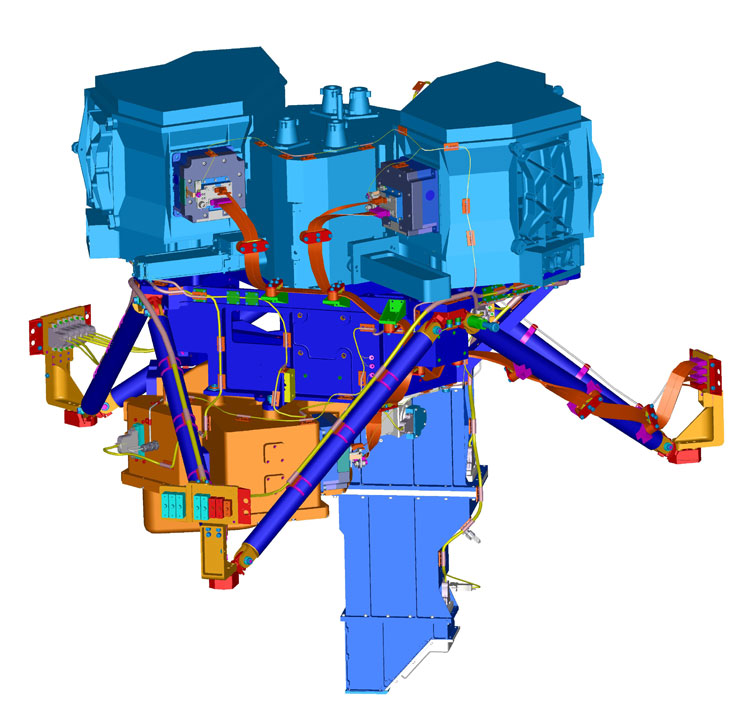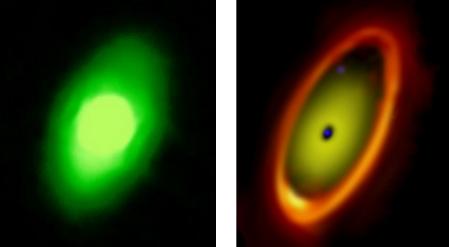That is a big mission statement considering that it encompasses everything from the very first luminous glowings after the Big Bang to the formation of solar systems capable of supporting life.

The Webb Space Telescope, or JWST, is an international collaboration between the European Space Agency, The Canadian Space Agency and NASA with Northrop Grummon acting as the primary contractor for it's construction. The Space Telescope Institute will be stepping in for the after launch phase.
Several innovative technologies will be used for
The Webb Telescope. These include:
- A folding, segmented primary mirror that will adjust to it's operational configuration after launch.ultra-lightweight beryllium optics
- Detectors capable of recording extremely weak signals
- Microshutters that enable programmable object selection for the spectrograph.
- Acryocooler for cooling the mid-IR detectors to 7K.

The beryllium mirror segments and science instruments are already under construction. In July 2008 NASA confirmed the JWST project went into its implementation phase and the project conducted a major mission review in March 2010.
There will be four main instruments on JWST:
 The Near InfraRed Camera (NIRCam) - Provided by the University of Arizona, this camera will be able to image a large field of view and display high angular resolution. It will cover a wavelength range of 0.6 - 5 micrometers using 10 mercury-cadmium-telluride (HgCdTe) detector arrays. In essence, it will provide an Optical Telescope Element wavefront sensor similar to an instan LASIK vision correction. This camera will be able to detect the early phases of star and galaxy formation, mapping dark matter through gravitational lensing and study stellar populations of nearby galaxies
The Near InfraRed Camera (NIRCam) - Provided by the University of Arizona, this camera will be able to image a large field of view and display high angular resolution. It will cover a wavelength range of 0.6 - 5 micrometers using 10 mercury-cadmium-telluride (HgCdTe) detector arrays. In essence, it will provide an Optical Telescope Element wavefront sensor similar to an instan LASIK vision correction. This camera will be able to detect the early phases of star and galaxy formation, mapping dark matter through gravitational lensing and study stellar populations of nearby galaxiesThe Near InfraRed Spectrograph (NIRSpec) - This technology will allow the Webb Telescope to obtain 100 simultaneous spectra in it's micro-electromechanical system called a "microshutter array." Each cells is barely as wide as a human hair and will have lids that open and close when a magnetic field is applied. Each cell can be controlled individually, allowing it to be opened or closed to view or block a portion of the sky. It will provide medium resolution spectroscopy over a wavelength range of 1 to 5 micrometer and a lower resolution spectroscopy of 0.6 to 5 micrometers. What that means is that it will be able to shut out the surrounding light sources in order to capture objects so far away and so faint that we have not been able to see them.
The Mid-InfraRed Instrument (MIRI) - Covering the wavelength range of 5 - 27 micrometer, it will be possible to detect galaxies cal "Lyman Dropouts" because they are undetectably black at wavelengths shorter than what are needed to strip electron in the lowest orbits of hydrogen atoms which indicate the emergence of galaxies. Older galaxies typically produce spectra three times greater than those detected by the MIRI. MIRI will be able to probe obscured active galactic nuclei to determine the evolution of super massive black holes. It will also probe how cold cloud cores collapse into stars previously hidden from our view.
The Fine Guidance Sensor Tunable Filter Camera (MIRSpec) - This is a wide-field, narrow-band camera which will provide imagery over a wavelength range of 1.6 to 4.9 micrometers, with a gap between 2.6 and 3.1 micrometers, via user-selected wavelengths and has a single HgCdTe detector array.
The image below shows the Spitzer/MIPS image of a debis disk (left) comparing it to how the system might look to the MIRI camera (right). Hopefully we will be able to find many more complex systems of this type using the MIRI.
These images illustrate the difference between the Spitzer Telescope (left) and the anticipated images that could be captured by the Webb Space Telescope.
A model of the James Webb Telescope is on display at NASA's Goddard Space Flight Centre in Greenbelt, Maryland.

There will be five main science themes for the JWST:
- The End of the Dark Ages
- First Light and Reionization
- The Assembly of Galaxies
- The Birth of Stars and Protoplanetary Systems
- The Planetary Systems and the Origins of Life






No comments:
Post a Comment